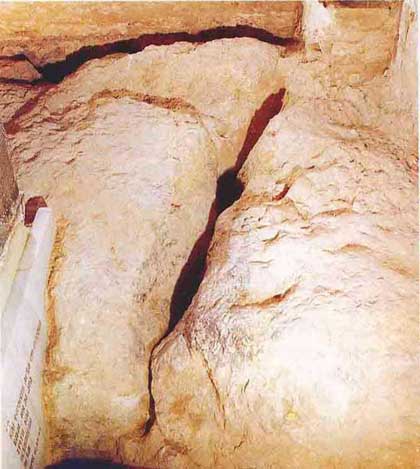5. Archeological Work  5.2 Holy Shrine of Calvary
5.2 Holy Shrine of Calvary
5.2 Holy Shrine of Calvary
The site of Calvary is, as well known, a place of tremendous religious significance inside the Holy Sepulchre Church, the place of the Crucifixion of Jesus Christ. The Rock is now visible and accessible again, due to the restoration work executed by G.P. Lavas and Theo Mitropoulos . The purpose was to remove the stone slabs which covered the site of the Crucifixion in order to make the site directly visible to pilgrims and visitors. Three areas of the newly uncovered Rock are of particular interest:
- A large, deep crack passing through the Rock to the right of the altar running from East to West.
- The sunken circular hole (receptacle) of stone located behind the centre of the altar.
- White plaster on the rock to the left of the altar with engraved crosses, two successive pavements and a section of an oblique wall.
The deep crack splits the visible part of the Calvary, running from the East to the West through almost the entire Rock. In certain parts, the crack reaches a width of 12cm and may have been the result of a powerful earthquake. The crack brings to mind Matthew 27: 51: «and the earth did quake. And the rocks rent…”, which occurred at the time of the Crucifixion. The sunken circular hole, partly broken, is found in the sunken area of the Rock, just behind the centre of the altar, and may mark the spot where the Cross was erected. A marble slab covered this element in order to protect it. The third point of interest lies to the left of the altar and includes white – colored plaster on the rock with crosses and parts of two successive pavements and also the above-mentioned oblique wall. The engraved crosses are of a very simple form and they are similar to several symbols found in ossuaries in Tapliot (now in Jerusalem), dated from the first to the third century according to Ignazio Manzinni. If this comparison is accepted, then our crosses may belong to the Preconstantinian period. Further findings were also identified, such as the above-mentioned parts of the two successive pavements and a section of an oblique wall running north to south, continuing under the altar. These pavements probably date to the eleventh and twelfth centuries, while the wall may be the one seen and described by the Russian Abbot Daniel in 1106-1107: «The Crucifixion of the Lord and the Holy Rock are all surrounded by a wall…».





















